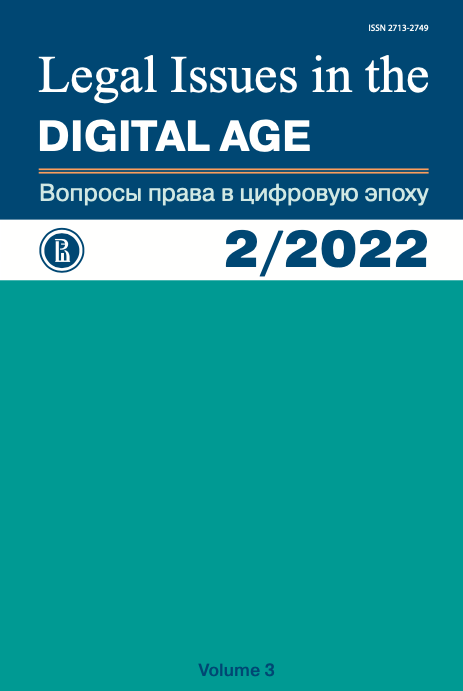Правовой статус эмитентов криптоактивов с точки зрения предполагаемого постановления МИКА.
Аннотация
В свете развития современных цифровых технологий встает вопрос о необходимости создания единого механизма регулирования эмитентов криптоактивов, включающего комплексное регулирование статуса всех субъектов, участвующих в торговле криптоактивами. Однако до сих пор мы отмечаем отсутствие единообразия и абстрактное регулирование основных субъектов, торгующих криптоактивами, вытекающее из V. AML директивы. Под давлением политиков и профессионального сообщества Европейская комиссия разработала проект долгожданного постановления MICA с целью обеспечения создания общего регулирования в области криптоактивов, которая будет применима во всех государствах-членах Европейского союза (далее — «ЕС»), включая государства-члены Единого экономического пространства (далее — «ЕЭП»). Предложенный Комиссией проект постановления MICA имеет целью унифицировать разрозненное правовое регулирование криптоактивов, которое государства-члены ЕС были вынуждены создать из-за отсутствия более масштабного регулирования этого института на уровне ЕС. Основной целью данной статьи является анализ вновь определенных институтов, включая категоризацию криптоактивов, охватываемых MICA. В этом контексте рассматриваются основные аспекты функционирования процесса эмиссии криптоактивов, включая обязанности публикации «white paper». Особо рассматривается роль Европейского банковского управления (European Banking Authority — далее «EBA») как надзорного органа над эмитентами известных криптоактивов. На основе анализа автор приходит к выводу, что применение положений MICA связано с рядом проблем, на которых затем останавливается более подробно. Неоднозначность в правовом применении MICA наблюдается, например, в случае регулирования понятий криптоактивов, которые носят общий характер, или в случае отсутствия более детального разъяснения сотрудничества между соответствующими органами ЕС и органами третьих стран, направленного на борьбу с отмыванием грязных денег и финансированием терроризма. При написании данной статьи были использованы следующие научные методы: формально-юридический, сравнительно-правовой, анализ, синтез, аналогия, индукция и дедукция.Литература
Blandin A., Cloots A. et al. (2019) Global Cryptoasset Regulatory Landscape Study. Cambridge: University Press, 122 p. DOI: https://doi.org/10.2139/ssrn.3379219
Bočánek M. (2021) First Draft of Crypto-Asset Regulation (MiCA) with the European Union and Potential Implementation. Financial Law Review, issue 22, pp. 37–53. DOI: https://doi.org/10.4467/22996834FLR.21.011.13979
Burilov V. (2019) Regulation of Crypto Tokens and Initial Coin Offerings in the EU de lege lata and de lege ferenda. European Journal of Comparative Law and Governance, vol. 6, pp. 146–186. DOI: https://doi.org/10.1163/22134514-00602003
Ferrari V. (2020) The regulation of crypto-assets in the EU — investment and payment tokens under the radar. Maastricht Journal of European and Comparative Law, vol. 27, pp. 325–342. DOI: https://doi.org/10.1177/1023263X20911538
Ferreira A., Sandner P., Dünser T. (2021) Cryptocurrencies, DLT and crypto assets: the road to regulatory recognition in Europe. Available at: https://ssrn.com/abstract=3891401 (accessed: 09.10.2021) DOI: https://doi.org/10.2139/ssrn.3891401
Hobza M. (2021) Challenges of Law in Business and Finance. 13th International Scholar Conference “Law in Business of Selected Member States of the European Union”. Prague: TROYAS, pp. 13–22.
Hornuf L., Kück T., Schwienbacher A. (2021) Initial coin offerings, information disclosure, and fraud. CESifo Working Paper No. 7962. Germany: Munich Society for the Promotion of Economic Research — CESifo GmbH, pp. 1–46.
Houben R., Snyers A. (2018) Cryptocurrencies and blockchain. Legal context and implications for financial crime, money laundering and tax evasion. Brussels: European Parliament, Policy Department for Economic, Research and Quality of Life Policies, 101 p.
Irwin A., Turner A. (2018) Illicit Bitcoin transactions: challenges in getting to who, what, when and where. Journal of Money Laundering Control, vol. 21, no. 3, pp. 297–313. DOI: https://doi.org/10.1108/JMLC-07-2017-0031
Moreno S., Seigneur J., Gotzev G. (2020) Handbook of Research on Cyber Crime and Information Privacy. Hershey: Information Science Reference, 400 p.
Sidak M., Slezáková A. (2014) Regulácia a dohľad nad činnosťou subjektov finančného trhu. Bratislava: Wolters Kluwer, 238 p. (in Slovak)
Winkler M. (2004) Legal aspects of conducting business by Slovak banks within the common market of the EU (on the example of the Czech Republic). Business Entrepreneurship and Marketing in the New European
Economic Area: Almanac of an International Conference on the Occasion of the 35th Anniversary of the Faculty of Business held under the auspices of Ivan Miklos, Deputy Prime Minister of the Slovak Republic.
Bratislava: EKONÓM, pp. 703–710.
Winkler M. (2018) Regulation of deadlines for issuing decisions in proceedings conducted pursuant to the Financial Market Supervision Act. Law governing conducting business in selected member states of the European Union. International Conference. Law governing conducting business in selected member states of the European Union. Almanac of the 10th International Scholar Conference. Prague: TROYAS, pp. 277–284.
Zetzsche D., Arner D., Buckley R. (2020) Decentralized Finance. Journal of Financial Regulation, vol. 6, issue 2, pp. 172–203. DOI: https://doi.org/10.1093/jfr/fjaa010
Zetzsche D., Arner D., Buckley R. (2020) The evolution and future of data-driven finance in the EU. Common Market Law Review, vol. 57, issue 2, pp. 331–360. DOI: https://doi.org/10.54648/COLA2020030
Zetzsche D., Arner D., Buckley R., Annunziata F. (2021) The Markets in Crypto-Assets regulation and the EU digital finance strategy. Capital Markets Law Journal, vol. 16, issue 2, pp. 203–225. DOI: https://doi.org/10.1093/cmlj/kmab005
Авторы, присылающие рукописи для рассмотрения к публикации в Журнале, принимают Политику лицензирования, авторских прав, открытого доступа и использования репозиториев.









